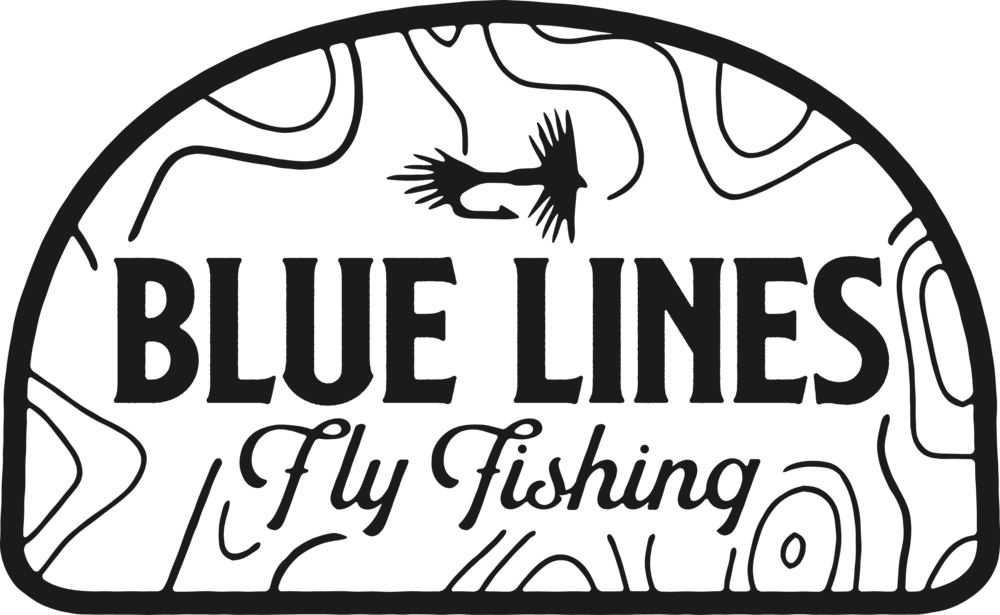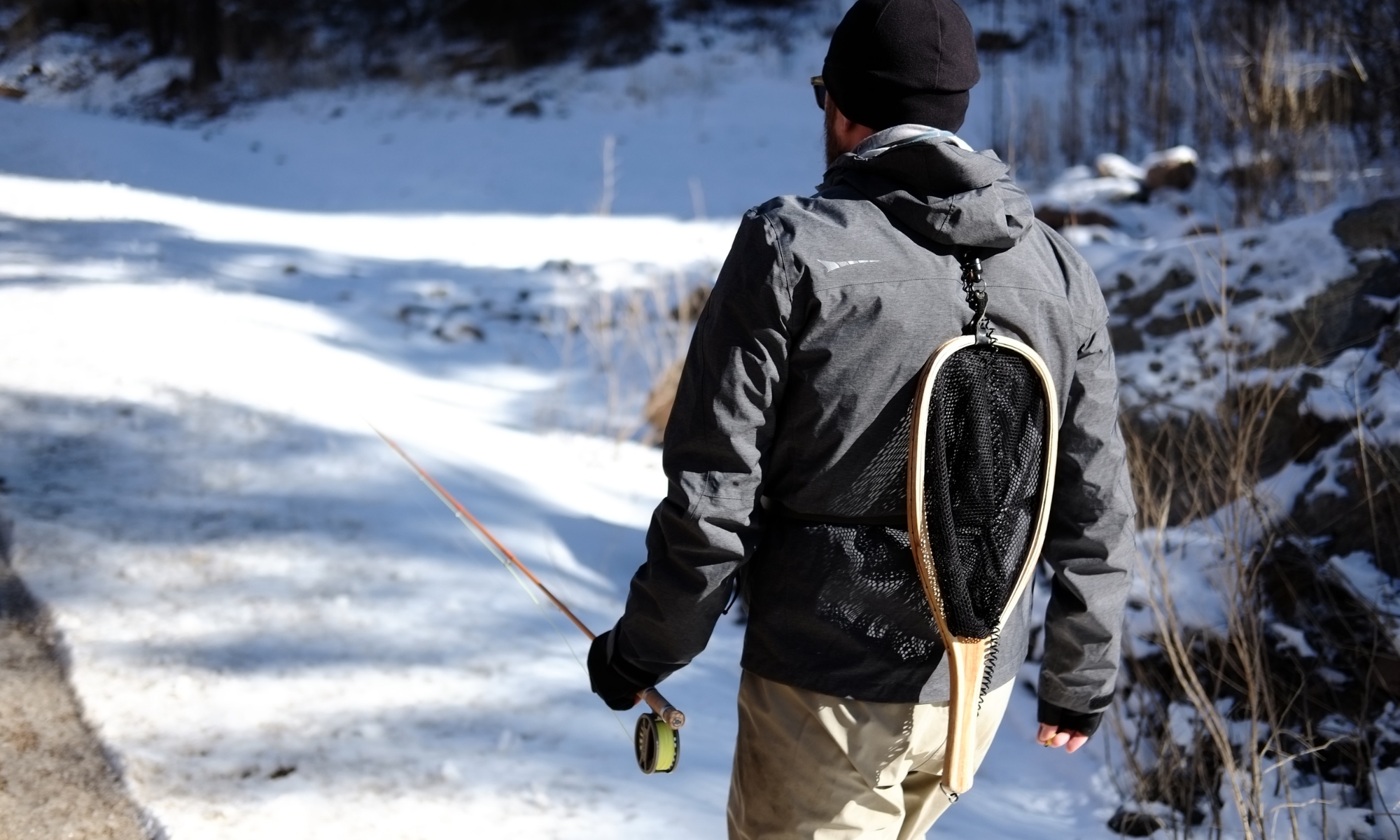By Sam Larson
The spillway of the Lake Estes dam is choked with chunks of blue-white ice. Up the valley and over the roofs of Estes Park proper, the Continental Divide is knife-sharp against the cloudless Colorado sky: stark, jagged, and cloaked in snow. A wall of arctic air tumbles over the peaks, picks up speed on its way through the valley, and slams straight into my face. The fly rod bends in the wind and the line whips like a pennant behind me, snapping and dancing across the top of the water. My hands, already red and chapped after a bare five minutes in the wind spent tying on nymphs and tippet, ache as I try to warm them in my pockets. I can feel the chill from the ground soaking upwards through my boots and favorite wool socks.
As I stomp up and down the banks it’s obvious that others before me had the same idea. Bootprints cover the snow and sand along the shore, and even now, when Siri is reporting negative temps into the mid-teens, there are a few other anglers huddled alongside the water, behind rocks and bridge pylons. I envy their RealTree neoprene outfits. I’m wearing two layers of long underwear beneath my uninsulated waders and it’s not enough. But the presence of others gives me the illusion of something like sanity. Or at least coddles me by driving the point home that I’m not the only one plumbing the depths of Seasonal Affective Disorder.
Memories of last summer’s fishing fueled me right up to the New Year, then the bottom fell out of it all and those memories turned stale and unsustaining. I wouldn’t be standing here staring at the only open stretch of flowing, fishable water within a three hour drive of my house if it were still possible to toast my metaphysical toes in the warmth of fishy memories from six months ago. Thus my annual, singular, and hated trip to the Estes Park Tailwater. It’s not the cold, really. Or the wind, though there’s a whole lot of that nearly every time I make the trek. It’s certainly not the water, which holds some truly fine specimens, trout measured in multiple pounds. I chalk up my unreasonable dislike for this blameless stretch of stream to one thing: tailwater nymphing.
I’ve never really gotten into the swing of tailwaters. I’ve fished most of the popular ones here in Colorado; the Arkansas, the Big Thompson, the Stagecoach Reservoir tailwater outside Steamboat. To generalize quickly, tailwaters house big fish. But because those big fish see so many flies on a yearly basis they are picky as hell. The math doesn’t pan out for me. Hours of technical nymphing, two boxes containing every nymph I can tie in four colors and three sizes, and a seine so I can find out what’s actually in the water (and that right there is what separates a decent day from six hours of frustration and flogging the water into a froth with your line) for a bare chance at catching a handful of large fish. I will take an underutilized Brookie stream, thank you very much. Six inch fish all day with no one around is the preferred path for me. But these are desperate times, after all. Those Brookie streams are iced over, either unfishable or inaccessible until Spring. And despite several winter’s worth of hard won experience and distaste I find myself back at a winter tailwater staring through icy clear water at a flotilla of large, actively feeding fish that have seen every fly I brought to the water and resolutely want nothing to do with any of it.
The first pool I approach has clearly been fished already that morning, with fresh boot tracks pressed into the sand. A fellow angler walks by behind me on his way back to the parking lot and pauses to lower his balaclava.
“They were really going after Jujubees earlier, but everything went down about an hour ago. I haven’t had a strike since then.” I thank him and put away the nymph I was tying on and start searching for a Juju baetis pattern. A bare minute outside the warmth of my pockets and my hands start to ache again. My first cast looks good, light and easy across the current. I start working the seam top to bottom, changing depth and drift length, trying to dial in where the fish are. A sudden gust of wind plummets down the valley and fouls my back cast. I fell the line dynamics change as I bring the rod forward and an untidy mess of tippet splashes into the water in front of me. The knots are a mind-boggling mess of line with a pair of nymphs hooked through it all for good measure. The cold air quickly freezes the water on the line and the wind knots ice over, making this chore all that much more fun.
Did I mention that my relationship with nymphing is fraught; complicated and untidy as my fly box after a full day of frantically changing flies to match the changing moods of tailwater trout? But if you want to brave a Colorado winter in search of piscine glory then you had better be prepared to nymph. I could dress it up and say that my distaste for it stems from its lack of elegance, or some other bullshit, but it’s truly rooted in the fact that I am bad at it. Note that I didn’t use kinder, gentler words there, like “mediocre”, or “competent”. Bad. Aggressively, unfailingly bad. Hand me a fly rod with a double nymph rig and some weight on the line and I will show you wind knots the likes of which will make a grown man break down in tears. I turn my back to the mountains and the wind, trying to protect my line from further tugs and tangles. My numb fingers can’t feel the 6x tippet and every tug only serves to make the knots tighter. With a deep sigh I reach for the nippers hanging from my chest pack and start cutting line. Welcome back to the Estes tailwater, I tell myself. I mumble some half-hearted lies about getting in the car, cranking the heater and heading back down the valley, about never coming back up here again. But with a final cut the mess of line comes away in my hand. I stuff it deep into a pocket and then dig out a fresh leader. Five minutes later I’m back at the shore, dead drifting a new pair of nymphs through a seam. After all, it’s winter. What the hell else am I going to do?

